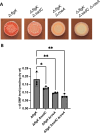Genetic analysis of flagellar-mediated surface sensing by Pseudomonas aeruginosa PA14
- PMID: 40470954
- PMCID: PMC12288467
- DOI: 10.1128/jb.00520-24
Genetic analysis of flagellar-mediated surface sensing by Pseudomonas aeruginosa PA14
Abstract
Surface sensing is a key aspect of the early stage of biofilm formation. For Pseudomonas aeruginosa PA14, the type IV pili (T4P), the T4P alignment complex, and PilY1 were shown to play a key role in c-di-GMP signaling upon surface contact. The role of the flagellar machinery in surface sensing is less well understood for P. aeruginosa. Here, we show, consistent with findings from other groups, that a mutation in the gene encoding the flagellar hook protein (ΔflgK) or flagellin (ΔfliC) results in a strain that overproduces the Pel exopolysaccharide (EPS) with a concomitant increase in c-di-GMP levels. We use a candidate gene approach and genetic screens, combined with phenotypic assays, to identify key roles for the MotAB and MotCD stators and the FliG protein, a component of the flagellar switch complex, in stimulating the surface-dependent, increased c-di-GMP level noted for these flagellar mutants. These findings are consistent with previous studies showing a role for the stators in surface sensing. We also show that mutations in the genes coding for the DGCs SadC and RoeA, as well as SadB, a protein involved in early surface colonization, abrogate the increased c-d-GMP-related phenotypes of the ΔflgK mutant. Together, these data indicate that bacteria monitor the status of flagellar synthesis and function during surface sensing as a mechanism to trigger the biofilm program.
Importance: Understanding how the flagellum contributes to surface sensing for P. aeruginosa is key to elucidating the mechanisms of biofilm initiation by this important opportunistic pathogen. Here, we take advantage of the observation that mutations in the flagellar hook protein or flagellin enhance surface sensing. We exploit this phenotype to identify key players in this signaling pathway, a critical first step in understanding the mechanistic basis of flagellar-mediated surface sensing. Our findings establish a framework for the future study of flagellar-based surface sensing.
Keywords: Pseudomonas aeruginosa; biofilm; flagella; stators; surface sensing.
Conflict of interest statement
The authors declare no conflict of interest.
Figures





Update of
-
Genetic Analysis of Flagellar-Mediated Surface Sensing by Pseudomonas aeruginosa PA14.bioRxiv [Preprint]. 2024 Dec 5:2024.12.05.627040. doi: 10.1101/2024.12.05.627040. bioRxiv. 2024. Update in: J Bacteriol. 2025 Jul 24;207(7):e0052024. doi: 10.1128/jb.00520-24. PMID: 39677620 Free PMC article. Updated. Preprint.
References
MeSH terms
Substances
Grants and funding
LinkOut - more resources
Full Text Sources

